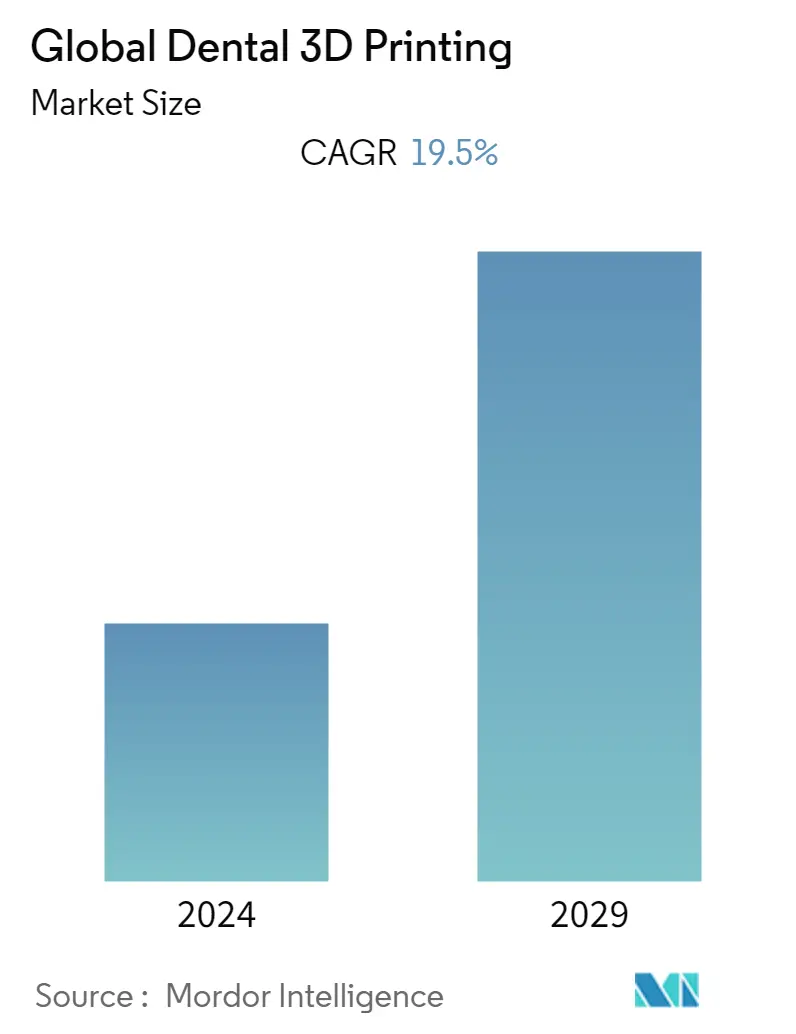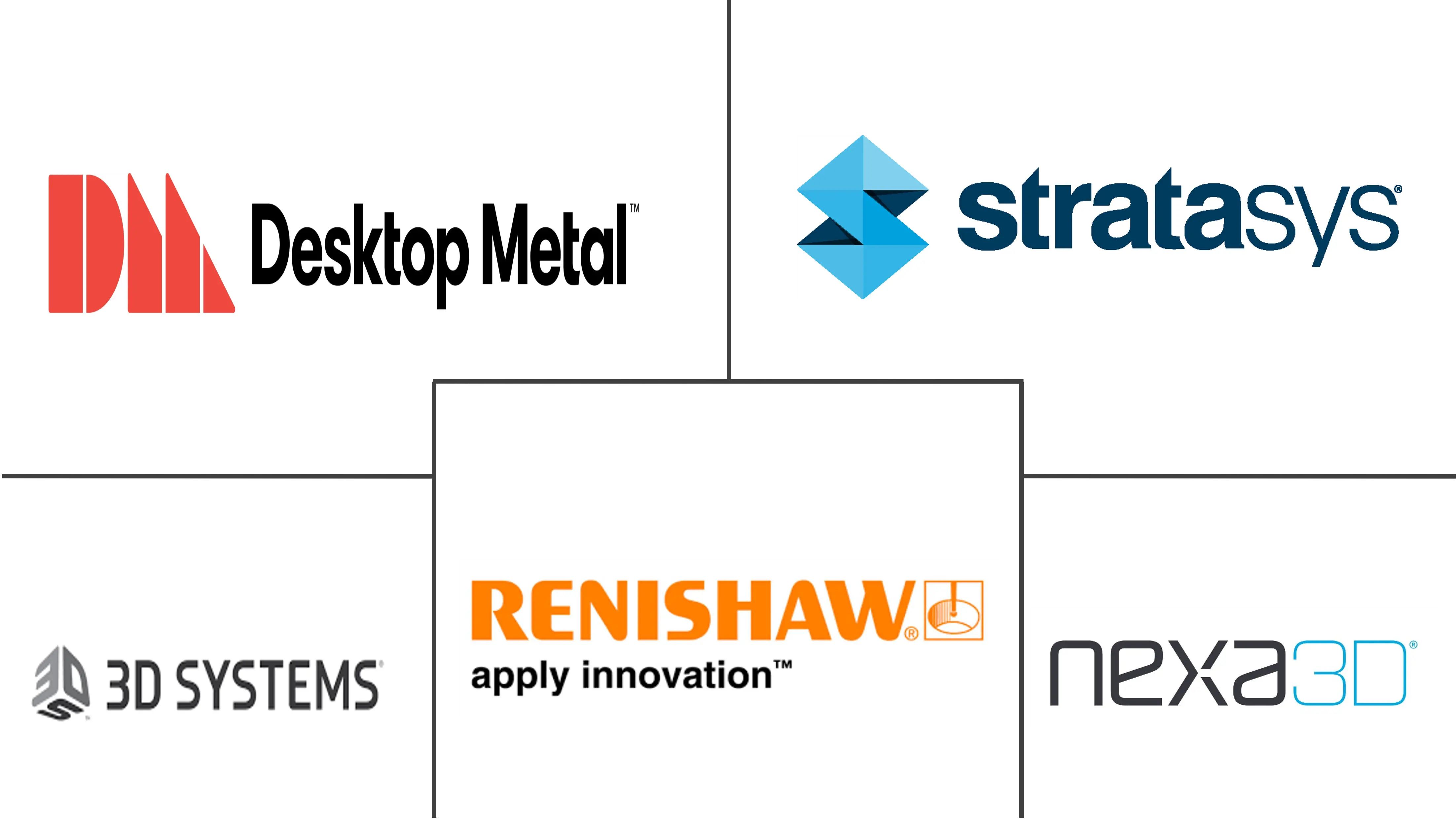Market Size of Global Dental 3D Printing

| Study Period | 2019 - 2029 |
| Base Year For Estimation | 2023 |
| CAGR | 19.50 % |
| Fastest Growing Market | Asia-Pacific |
| Largest Market | North America |
| Market Concentration | Medium |
Major Players
*Disclaimer: Major Players sorted in no particular order |
Need a report that reflects how COVID-19 has impacted this market and its growth?
Dental 3D Printing Market Analysis
The dental 3D printing market is projected to register a CAGR of 19.5% during the forecast period (2022-2027).
The COVID-19 epidemic has wreaked havoc on a variety of industries, with dentistry being one of the hardest hit. The epidemic of coronavirus disease 2019 (COVID-19) essentially shut down around 198,000 active dentists and dental specialists in the United States, according to an essay published in August 2020 titled "COVID-19 and Dentistry: Challenges and Opportunities for Providing Safe Care." Moreover, the demand and sale of dental equipment and procedures were negatively impacted due to the global restrictions and lockdown in most countries. Furthermore, many device manufacturers shifted their focus to fight against coronavirus. For instance, in March 2020, 3D printer company Formlabs reported that it was using its more than 250 in-house 3D printers at its printing facility in Ohio to produce up to 150,000 COVID-19 test swabs per day. However, the medical device industry is trying to recover from the COVID-19 outbreak.
While the impact of COVID-19 continues to disrupt many sectors, the 3D-printing industry appears to have regained strength and is moving on a steady upward trajectory, according to a news article published in December 2021. Many factors in the dental industry have fueled this growth, including the need to streamline chairside appointments and improve safety for both dentists and patients. In the third quarter, 3D Systems, a leader in the dental industry for more than 30 years, saw double-digit growth compared to 2020 results. Healthcare revenue increased by 28.3% to USD 76.4 million, compared to the same period last year. When divestitures were taken into account, 3D Systems reported that high demand for dental applications, both printers, and materials, resulted in overall healthcare revenue increasing by 44.5% year over year.
Materialize is another company that is expanding. The Belgium-based company reported a 28.0% revenue increase in 2021 compared to 2020, with revenue for its medical segment up 10.2% and manufacturing up 62.0%, among several key areas of focus. Furthermore, Stratasys, a leading 3D-printing company for industries such as healthcare, consumer goods, and more, reported revenue growth of 24.3% and systems sales growth of 34.7% year over year. Revenue increased from USD 127.9 million in 2020 to USD 159.0 million in 2021, according to the company's third-quarter report. This was owing to contributions across all regions and all business lines.
In dentistry, technological advancements act as a catalyst for innovation and growth. This is especially true in digital dentistry. Although not everyone has embraced this technological evolution, most dental professionals would agree that going digital is the way to go. For starters, the advantages of 3D printing in dentistry are numerous. It allows dental professionals to stay current while also being more cost-effective than analog methods. There are frequent software updates, new dental materials launches, and rapidly evolving dental applications. For instance, in February 2022, Nobio announced the official launch of infinix, a new line of advanced antimicrobial restorative materials designed to fight recurrent decay. Also, in November 2019, Apex Dental Materials introduced RE-GEN, a suite of bioactive materials comprised of a Flowable Composite, Bulk Fill & Resin Cement, Pit & Fissure Sealant, and the world's first-ever Bioactive Universal and Self-Etch Adhesives.
Besides, 3D printing can significantly improve the workflow in any dental practice or laboratory and can drastically reduce patient chair time. It provides product customization flexibility as well as superior quality and accuracy in 3D-printed dental models. Dental professionals can now print occlusal splints and other dental models in-house in just one day, which was once unthinkable. This not only helps to generate revenue but also makes dental treatment easier. 3D printing materials are constantly evolving to provide users with a growing list of indications, and 3D printing can be easily integrated into any dental practice or laboratory's workflow.
The market is also driven by an increase in the number of dental caries and the need to treat them around the world. According to an article published in July 2019 titled "Oral Illnesses: A Global Public Health Concern," oral diseases are among the most common diseases worldwide, posing substantial health and economic burdens, and significantly lowering people's quality of life. Dental caries (tooth decay), periodontal disease, tooth loss, and malignancies of the lips and oral cavity are the most common and serious oral disorders worldwide. In addition, as per the World Health Organization (WHO), data updated in March 2020, estimates that oral disorders impact approximately 3.5 billion people globally, and severe periodontal (gum) disease, which can lead to tooth loss, is also highly common.
Hence, increasing dental caries, technological advancements, the launch of new products, and the benefits associated with the 3D printing technology are all factors that are projected to boost the market growth over the forecast period.

